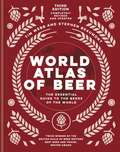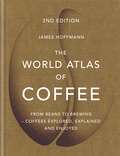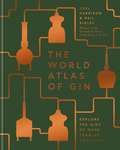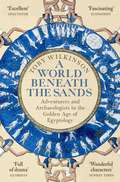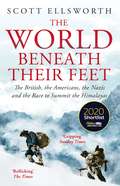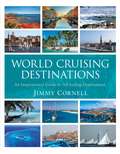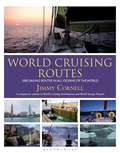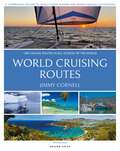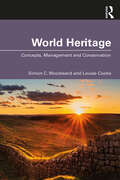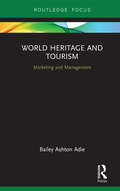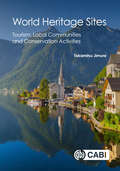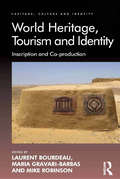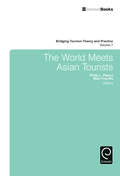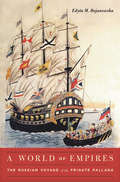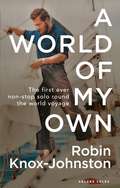- Table View
- List View
The World as I Have Found It
by Mary L. Day ArmsA graduate of the Maryland Institution for the Blind, Mary L. Day published a memoir in 1859 entitled Incidents in the Life of a Blind Girl. In this book, a sequel to her first, she recounts how she traveled throughout the country earning a living through the sale of her memoir. She also writes about meeting her future husband, visiting places of interest, and having numerous adventures on the road. The book closes with several essays on blindness and the education of the blind and with a collection of poems by blind authors.
World Atlas of Beer: THE ESSENTIAL NEW GUIDE TO THE BEERS OF THE WORLD (World Atlas Of)
by Stephen Beaumont Tim WebbAs craft brewing continues to go from strength to strength across the world, World Atlas of Beer is the definitive and essential guide to beer. Understand the rich, multi-faceted traditions of Belgium, the Nordic legend that is Finnish Sahti, the relatively new phenomenon of the New England hazy IPA, and why Australia's lower-strength beers are one of its great successes. With thousands of breweries now operating around the globe, and more opening every day, this is the expert guide to what is really worth drinking.Country by country the book considers a vast range of brewing techniques, beer styles and traditions. Detailed maps describe crucial trends in major territories and features such as matching beer with food and how to pour different kinds of beer complete the picture. Now in a fully updated third edition, this book is the perfect companion to help you explore the best beers the world has to offer.Praise for the second edition of World Atlas of Beer:'Written with authority and wit... the perfect guide to the rapidly changing beer scene' - the Guardian
The World Atlas of Coffee: From beans to brewing - coffees explored, explained and enjoyed (World Atlas Of)
by James HoffmannThe worldwide bestseller - 1/3 million copies sold'With his expert guidance we travel around the globe, from Burundi to Honduras via Vietnam, sipping and spitting as we go. This is high geekery made palatable by the evident love pulsing through every sentence.' - The Guardian'The subject of coffee has never been more, er, hot, and The World Atlas of Coffee takes a close look at its history and evolution, the international range of beans and all the best ways to enjoy coffee. Great pics too.'- Susy Atkins, The TelegraphFor everyone who wants to understand more about coffee and its wonderful nuances and possibilities, this is the book to have.Coffee has never been better, or more interesting, than it is today. Coffee producers have access to more varieties and techniques than ever before and we, as consumers, can share in that expertise to make sure the coffee we drink is the best we can find. Where coffee comes from, how it was harvested, the roasting process and the water used to make the brew are just a few of the factors that influence the taste of what we drink. Champion barista and coffee expert James Hoffmann examines these key factors, looking at varieties of coffee, the influence of terroir, how it is harvested and processed, the roasting methods used, through to the way in which the beans are brewed.Country by country - from Bolivia to Zambia - he then identifies key characteristics and the methods that determine the quality of that country's output. Along the way we learn about everything from the development of the espresso machine, to why strength guides on supermarket coffee are really not good news. This is the first book to chart the coffee production of over 35 countries, encompassing knowledge never previously published outside the coffee industry.
The World Atlas of Gin: Explore the gins of more than 50 countries
by Joel Harrison Neil RidleyFor everyone and anyone who wants to understand more about gin, this is the definitive guide - covering the best gins the world has to offer, history and production methods, and the countries that have helped make gin a global success story.Never has there been a more striking revolution in the world of distilled spirits than the current renaissance of gin. With small craft distilleries popping up all over the world, from Texas to Tasmania, more varieties and techniques being used than ever before, and a tapestry of tastes from light and citrusy to big bold savoury notes, gin's appeal is extraordinarily wide and varied.From gin made in small batches from local botanicals, through to large facilities which make some of the world's most recognized gin brands, World Atlas of Gin looks at everything from the botanical to the bottle: how and where botanicals are grown and harvested and their role within the flavour of gin; producers and the stories behind their brands; exactly where, and how, gins are made; and, country by country, the best examples to try. Global cocktails are covered too, including the history and country of origin of some of the best-known mixed gin drinks.
A World Beneath the Sands: Adventurers and Archaeologists in the Golden Age of Egyptology
by Toby WilkinsonWhat could be more exciting, more exotic or more intrepid than digging in the sands of Egypt in the hope of discovering golden treasures from the age of the pharaohs?Our fascination with ancient Egypt goes back to the ancient Greeks. But the heyday of Egyptology was undoubtedly the nineteenth and early twentieth centuries. This golden age of scholarship and adventure is neatly book-ended by two epoch-making events: Champollion's decipherment of hieroglyphics in 1822 and the discovery of Tutankhamun’s tomb by Howard Carter and Lord Carnarvon a hundred years later.In A World Beneath the Sands, the acclaimed Egyptologist Toby Wilkinson tells the riveting stories of the men and women whose obsession with Egypt's ancient civilisation drove them to uncover its secrets. Champollion, Carter and Carnarvon are here, but so too are their lesser-known contemporaries, such as the Prussian scholar Karl Richard Lepsius, the Frenchman Auguste Mariette and the British aristocrat Lucie Duff-Gordon. Their work – and those of others like them – helped to enrich and transform our understanding of the Nile Valley and its people, and left a lasting impression on Egypt, too. Travellers and treasure-hunters, ethnographers and epigraphers, antiquarians and archaeologists: whatever their motives, whatever their methods, all understood that in pursuing Egyptology they were part of a greater endeavour – to reveal a lost world, buried for centuries beneath the sands.'It is a story full of drama, with the Nile, the pyramids and the Valley of the Kings as backdrop. That A World Beneath the Sands is also a subtle and stimulating study of the paradoxes of 19th-century colonialism is a bonus indeed.' – Tom Holland, Guardian
The World Beneath Their Feet: The British, the Americans, the Nazis and the Mountaineering Race to Summit the Himalayas
by Scott EllsworthOne of the most compelling international dramas of the 20th century and an unforgettable saga of survival, technological innovation, and breathtaking human physical achievement-all set against the backdrop of a world headed toward war.While tension steadily rose between European powers in the 1930s, a different kind of battle was raging across the Himalayas. Contingents from Great Britain, Nazi Germany, and the United States had set up rival camps at the base of the mountains, all hoping to become recognized as the fastest, strongest, and bravest climbers in the world.Carried on across nearly the entire sweep of the Himalayas, this contest involved not only the greatest mountain climbers of the era, but statesmen and millionaires, world-class athletes and bona fide eccentrics, scientists and generals, obscure villagers and national heroes. Centered in the 1930s, with one brief, shining postwar coda, the contest was a struggle between hidebound traditionalists and unknown innovators, one that featured new techniques and equipment, unbelievable courage and physical achievement, and unparalleled valor. And death. One Himalayan peak alone, Nanga Parbat in Kashmir, claimed twenty-five lives in less than three years.Climbing the Himalayas was the Greatest Generation's moonshot--one shrouded in the onset of war, interrupted by it, and then fully accomplished. A gritty, fascinating history that promises to enrapture fans of Hampton Side, Jon Krakauer, and Laura Hillenbrand, The World Beneath Their Feet brings this forgotten story back to life.
World Cruising Destinations: An Inspirational Guide to all Sailing Destinations
by Jimmy Cornell'What Jimmy Cornell doesn't know about cruising isn't worth knowing' - Yachting WorldOne of the most influential cruising yachtsmen writing today, Jimmy Cornell has sailed over 200,000 miles on all the oceans of the world, including three circumnavigations and voyages to the Arctic and Antarctic. His successful guide to sailing around the world, World Cruising Routes, has helped many aspirational voyagers turn their dreams into reality and follow in his footsteps.This substantial new handbook profiles every cruising destination in the world and is intended as a partner to Cornell's bestselling World Cruising Routes. Every destination is detailed comprehensively, with information on cruising attractions, history, culture, climate(including average monthly temperatures and rainfall, plus tropical storm seasons), local laws, regulations and formalities, facilities available, plus public holidays and events, emergency telephone numbers, and much more. Lavishly illustrated throughout, it is not only a must-have onboard reference work for long distance sailors, but will undoubtedly inspire the adventurous to sail where they have never sailed before.
World Cruising Routes: 1000 sailing routes in all oceans of the world (Woodenboat Bks.)
by Jimmy CornellLong established as the bible for long-distance cruisers and a bestseller for more than 25 years, World Cruising Routes is the indispensable planning guide to nearly 1,000 sailing routes covering all the oceans of the world from the tropical South Seas to the high latitudes of the Arctic and Antarctic, geared specifically to the needs of cruising sailors. It contains information on the winds, currents, regional and seasonal weather, as well as suggestions about optimum times for individual routes.The 7th edition assesses the effects of global warming on cruising routes and provides over 6,000 waypoints toassist skippers in planning individual routes. It is the perfect one-stop reference for planning a cruise anywhere in the world.'The most important book for long-distance voyagers to come along in decades.'Cruising World
World Cruising Routes: 1,000 Sailing Routes in All Oceans of the World
by Jimmy Cornell Jimmy Cornell (plotter agent)Long established as the bible for long-distance cruisers and a bestseller for more than 25 years, World Cruising Routes is the indispensable planning guide to nearly 1,000 sailing routes covering all the oceans of the world from the tropical South Seas to the high latitudes of the Arctic and Antarctic, geared specifically to the needs of cruising sailors. It contains information on the winds, currents, regional and seasonal weather, as well as suggestions about optimum times for individual routes.This new, fully revised and updated 8th edition assesses how changes around the world have affected cruising routes and how climatic change has altered the cruising landscape and necessitated adaptations in timing and route-planning. It provides over 6,000 waypoints to assist skippers in planning individual routes. It is the perfect one-stop reference for planning a cruise anywhere in the world.'The most important book for long-distance voyagers to come along in decades.'Cruising World
World globe centred on the UK (large print)
by RnibThis is a globe map centred on the United Kingdom. As the land masses shown are on the curved surface of the Earth, this image will be distorted, especially at its edge. There is a locator dot shown, which will be at the top left of the page when the image is the correct way up. Land is shown on the tactile image as a fine dotted texture and the sea by fine horizontal lines. These are green and blue respectively on the Large Print image. This globe map represents the Earth as seen from space, directly above the United Kingdom. The UK is in the centre of the map, to its right is mainland Europe and further right is the continent of Asia. Down the page from the UK is Spain and Portugal, and further down is the continent of Africa, reaching to the bottom of the globe. Up and left from the UK are the Atlantic Ocean, Iceland and Greenland. To the left of the UK are the eastern half of North America with the Arctic up the page and the northern tip of South America down the page.
World globe centred on the UK (UEB contracted)
by RnibThis is a globe map centred on the United Kingdom. As the land masses shown are on the curved surface of the Earth, this image will be distorted, especially at its edge. There is a locator dot shown, which will be at the top left of the page when the image is the correct way up. Land is shown on the tactile image as a fine dotted texture and the sea by fine horizontal lines. These are green and blue respectively on the Large Print image. This globe map represents the Earth as seen from space, directly above the United Kingdom. The UK is in the centre of the map, to its right is mainland Europe and further right is the continent of Asia. Down the page from the UK is Spain and Portugal, and further down is the continent of Africa, reaching to the bottom of the globe. Up and left from the UK are the Atlantic Ocean, Iceland and Greenland. To the left of the UK are the eastern half of North America with the Arctic up the page and the northern tip of South America down the page.
World globe centred on the UK (UEB uncontracted)
by RnibThis is a globe map centred on the United Kingdom. As the land masses shown are on the curved surface of the Earth, this image will be distorted, especially at its edge. There is a locator dot shown, which will be at the top left of the page when the image is the correct way up. Land is shown on the tactile image as a fine dotted texture and the sea by fine horizontal lines. These are green and blue respectively on the Large Print image. This globe map represents the Earth as seen from space, directly above the United Kingdom. The UK is in the centre of the map, to its right is mainland Europe and further right is the continent of Asia. Down the page from the UK is Spain and Portugal, and further down is the continent of Africa, reaching to the bottom of the globe. Up and left from the UK are the Atlantic Ocean, Iceland and Greenland. To the left of the UK are the eastern half of North America with the Arctic up the page and the northern tip of South America down the page.
World Heritage: Concepts, Management and Conservation
by Simon C. Woodward Louise CookeWorld Heritage: Concepts, Management and Conservation presents an insight into discussions and debates surrounding the UNESCO World Heritage List, and the properties on it. Since its creation 50 years ago, the World Heritage Convention has been lauded as one of the most successful international expressions of cooperation, whilst at the same time being widely criticised as producing an overly commercialised and globalised sense of heritage. Offering an in-depth discussion of both sides of the debate, this book explores these issues by discussing the following topics: • How the World Heritage Convention was conceived and how it is operationalised; • How the World Heritage concept is currently being used and misused; • The benefits of inscription – perceived and actual existential threats faced by World Heritage Site managers including climate change, urban development, overtourism, military action and natural disaster; • The future of World Heritage as an instrument for conservation and economic development. Case studies from a global range of World Heritage Sites are included throughout, to showcase some of the successes and also missuses of World Heritage status. This book will be of pivotal interest to students and scholars in the fields of tourism, heritage, archaeology, natural resource management and development studies.
World Heritage: Concepts, Management and Conservation
by Simon C. Woodward Louise CookeWorld Heritage: Concepts, Management and Conservation presents an insight into discussions and debates surrounding the UNESCO World Heritage List, and the properties on it. Since its creation 50 years ago, the World Heritage Convention has been lauded as one of the most successful international expressions of cooperation, whilst at the same time being widely criticised as producing an overly commercialised and globalised sense of heritage. Offering an in-depth discussion of both sides of the debate, this book explores these issues by discussing the following topics: • How the World Heritage Convention was conceived and how it is operationalised; • How the World Heritage concept is currently being used and misused; • The benefits of inscription – perceived and actual existential threats faced by World Heritage Site managers including climate change, urban development, overtourism, military action and natural disaster; • The future of World Heritage as an instrument for conservation and economic development. Case studies from a global range of World Heritage Sites are included throughout, to showcase some of the successes and also missuses of World Heritage status. This book will be of pivotal interest to students and scholars in the fields of tourism, heritage, archaeology, natural resource management and development studies.
World Heritage and Tourism: Marketing and Management (Routledge Focus on Tourism and Hospitality)
by Bailey Ashton AdieThis book provides a comprehensive discussion of the phenomenon of World Heritage tourism through a critical, global perspective that encompasses both supply and demand. Individual chapters critically engage with four main topics crucial to this subject area. A chapter on visitors defines the World Heritage tourist segment, highlighting on-site behavior and visitor needs. Building on this, a marketing chapter questions the functionality of the World Heritage brand as a tourist attractor and instead argues that tourist growth is due to effective marketing following World Heritage inscription. The third chapter presents a holistic management framework centred on planning, place, and people, while the concluding chapter situates World Heritage tourism in a global context, discussing threats such as climate change. International case studies from a wide variety of both natural and cultural sites provide a representative discussion of the topic across varying geographical, political, and cultural contexts. This will be of great interest to upper-level students, researchers, and academics in the fields of tourism, heritage studies, and geography, as well as practitioners in these fields who wish to better understand the crucial interplay of these areas.
World Heritage and Tourism: Marketing and Management (Routledge Focus on Tourism and Hospitality)
by Bailey Ashton AdieThis book provides a comprehensive discussion of the phenomenon of World Heritage tourism through a critical, global perspective that encompasses both supply and demand. Individual chapters critically engage with four main topics crucial to this subject area. A chapter on visitors defines the World Heritage tourist segment, highlighting on-site behavior and visitor needs. Building on this, a marketing chapter questions the functionality of the World Heritage brand as a tourist attractor and instead argues that tourist growth is due to effective marketing following World Heritage inscription. The third chapter presents a holistic management framework centred on planning, place, and people, while the concluding chapter situates World Heritage tourism in a global context, discussing threats such as climate change. International case studies from a wide variety of both natural and cultural sites provide a representative discussion of the topic across varying geographical, political, and cultural contexts. This will be of great interest to upper-level students, researchers, and academics in the fields of tourism, heritage studies, and geography, as well as practitioners in these fields who wish to better understand the crucial interplay of these areas.
World Heritage Sites: Tourism, Local Communities and Conservation Activities
by Dr Takamitsu JimuraHeritage is a growing area of both tourism and study, with World Heritage Site designations increasing year-on-year. This book reviews the important interrelations between the industry, local communities and conservation work, bringing together the various opportunities and challenges for different destinations. World Heritage status is a strong marketing brand, and proper heritage management and effective conservation are vital, but this tourism must also be developed and managed appropriately if it is to benefit a site. As many sites are located in residential areas, their interaction with the local community must also be carefully considered. This book: - Reviews new areas of development such as Historic Urban Landscapes, Intangible Cultural Heritage, Memory of the World and Global Geoparks. - Includes global case studies to relate theory to practice. - Covers a worldwide industry of over 1,000 cultural and natural heritage sites. An important read for academics, researchers and students of heritage studies, cultural studies and tourism, this book is also a useful resource for professionals working in conservation, cultural and natural heritage management.
World Heritage, Tourism and Identity: Inscription and Co-production (Heritage, Culture and Identity)
by Laurent Bourdeau Maria Gravari-BarbasThe remarkable success of the 1972 UNESCO Convention Concerning the Protection of World Cultural and Natural Heritage is borne out by the fact that nearly 1,000 properties have now been designated as possessing Outstanding Universal Value and recognition given to the imperative for their protection. However, the remarkable success of the Convention is not without its challenges and a key issue for many Sites relates to the touristic legacies of inscription. For many sites inscription on the World Heritage List acts as a promotional device and the management challenge is one of protection, conservation and dealing with increased numbers of tourists. For other sites, designation has not brought anticipated expansion in tourist numbers and associated investments. What is clear is that tourism is now a central concern to the wide array of stakeholders involved with World Heritage Sites.
World Heritage, Tourism and Identity: Inscription and Co-production (Heritage, Culture and Identity)
by Laurent Bourdeau Maria Gravari-Barbas Mike RobinsonThe remarkable success of the 1972 UNESCO Convention Concerning the Protection of World Cultural and Natural Heritage is borne out by the fact that nearly 1,000 properties have now been designated as possessing Outstanding Universal Value and recognition given to the imperative for their protection. However, the remarkable success of the Convention is not without its challenges and a key issue for many Sites relates to the touristic legacies of inscription. For many sites inscription on the World Heritage List acts as a promotional device and the management challenge is one of protection, conservation and dealing with increased numbers of tourists. For other sites, designation has not brought anticipated expansion in tourist numbers and associated investments. What is clear is that tourism is now a central concern to the wide array of stakeholders involved with World Heritage Sites.
World Map- basic outline (tactile)
by Sheffield Vi ServiceThis is an outline map of the world with North and South America to the left, Australia to the right and Antarctica at the bottom of the image.
World Map (large print)
by RnibThis is a map of the world. The map is framed by a dashed image border. There is a locator dot shown, which will be at the top left of the page when the image is the right way up. All land masses are textured (green) and sea areas are untextured (blue). On the left of the page are North and South America, in the centre Europe and Africa and to the right Asia and Australasia. Some areas have been given two-letter alphabetic labels due to space considerations. These are described in a key at the bottom left of the page.
The World Meets Asian Tourists (Bridging Tourism Theory and Practice #7)
by Jafar Jafari Liping A. Cai Philip L. Pearce Mao-Ying WuThe movement of Asian citizens across continents now occurs on an unprecedented scale, with a surge in Asian tourists now visiting Europe, North America, Africa and Oceania. Tourists from China, Taiwan, India, Thailand, Malaysia, and to a lesser extent Korea and Japan are meeting the citizens of cultures they had previously only been able to read about or view from afar. This book seeks to understand the experiences of, and reactions to, Asian tourists travelling out of Asia.Questions about Asian tourist contact with unfamiliar countries and cultures will be addressed. What are the interests of Asian tourists and what drives these interests? What impacts are they having on host communities, both in terms of the provision and co-creation of desired experiences and in the human dimensions of social contact? The volume addresses fresh implications for marketing, planning and policy which these tourist markets pose for good governance. This book confronts the limitations of our understanding of how to manage the tourist experience when that understanding has been built almost entirely on the behaviours and travels of western tourists.
A World of Empires: The Russian Voyage of the Frigate <i>Pallada</i>
by Edyta M. BojanowskaMany people are familiar with American Commodore Matthew Perry’s expedition to open trade relations with Japan in the early 1850s. Less well known is that on the heels of the Perry squadron followed a Russian expedition secretly on the same mission. Serving as secretary to the naval commander was novelist Ivan Goncharov, who turned his impressions into a book, The Frigate Pallada, which became a bestseller in imperial Russia. In A World of Empires, Edyta Bojanowska uses Goncharov’s fascinating travelogue as a window onto global imperial history in the mid-nineteenth century. Reflecting on encounters in southern Africa’s Cape Colony, Dutch Java, Spanish Manila, Japan, and the British ports of Singapore, Hong Kong, and Shanghai, Goncharov offers keen observations on imperial expansion, cooperation, and competition. Britain’s global ascendancy leaves him in equal measures awed and resentful. In Southeast Asia, he recognizes an increasingly interlocking world in the vibrant trading hubs whose networks encircle the globe. Traveling overland back home, Goncharov presents Russia’s colonizing rule in Siberia as a positive imperial model, contrasted with Western ones. Slow to be integrated into the standard narrative on European imperialism, Russia emerges here as an increasingly assertive empire, eager to position itself on the world stage among its American and European rivals and fully conversant with the ideologies of civilizing mission and race. Goncharov’s gripping narrative offers a unique eyewitness account of empire in action, in which Bojanowska finds both a zeal to emulate European powers and a determination to define Russia against them.
A World of Empires: The Russian Voyage of the Frigate <i>Pallada</i>
by Edyta M. BojanowskaMany people are familiar with American Commodore Matthew Perry’s expedition to open trade relations with Japan in the early 1850s. Less well known is that on the heels of the Perry squadron followed a Russian expedition secretly on the same mission. Serving as secretary to the naval commander was novelist Ivan Goncharov, who turned his impressions into a book, The Frigate Pallada, which became a bestseller in imperial Russia. In A World of Empires, Edyta Bojanowska uses Goncharov’s fascinating travelogue as a window onto global imperial history in the mid-nineteenth century. Reflecting on encounters in southern Africa’s Cape Colony, Dutch Java, Spanish Manila, Japan, and the British ports of Singapore, Hong Kong, and Shanghai, Goncharov offers keen observations on imperial expansion, cooperation, and competition. Britain’s global ascendancy leaves him in equal measures awed and resentful. In Southeast Asia, he recognizes an increasingly interlocking world in the vibrant trading hubs whose networks encircle the globe. Traveling overland back home, Goncharov presents Russia’s colonizing rule in Siberia as a positive imperial model, contrasted with Western ones. Slow to be integrated into the standard narrative on European imperialism, Russia emerges here as an increasingly assertive empire, eager to position itself on the world stage among its American and European rivals and fully conversant with the ideologies of civilizing mission and race. Goncharov’s gripping narrative offers a unique eyewitness account of empire in action, in which Bojanowska finds both a zeal to emulate European powers and a determination to define Russia against them.
A World of My Own: The First Ever Non-stop Solo Round The World Voyage
by Robin Knox-JohnstonOn Friday 14 June 1968 Suhaili, a tiny ketch, slipped almostunnoticed out of Falmouth harbour steered by the solitary figure at herhelm, Robin Knox-Johnston. Ten and a half months later Suhaili,paintwork peeling and rust streaked, her once white sails weathered andbrown, her self-steering gone, her tiller arm jury rigged to the rudderhead, came romping joyously back to Falmouth to a fantastic receptionfor Robin, who had become the first man to sail round the worldnon-stop single-handed. By every standard it was an incredible adventure, perhaps the lastgreat uncomputerised journey left to man. Every hazard, everytemptation to abandon the astounding voyage came Robin's way, frompolluted water tanks, smashed cabin top and collapsed boom to lostself-steering gear and sheered off tiller, and all before the tinyketch had fought her way to Cape Horn, the point of no return, thefearsome test of any seaman's nerve and determination. A World of My Own is Robin's gripping, uninhibited, movingaccount of one of the greatest sea adventures of our time. An instantbestseller, it is now reissued for a new generation of readers to beenthralled and inspired.

